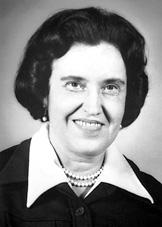Rosalyn Yalow (Medical Physicist/Nobel Prize Winner)
 Rosalyn Sussman Yalow (born July 19, 1921) is an American medical physicist, and a co-winner of the 1977 Nobel Prize in Physiology or Medicine (together with Roger Guillemin and Andrew Schally) for development of the radioimmunoassay (RIA) technique.
Rosalyn Sussman Yalow (born July 19, 1921) is an American medical physicist, and a co-winner of the 1977 Nobel Prize in Physiology or Medicine (together with Roger Guillemin and Andrew Schally) for development of the radioimmunoassay (RIA) technique.
She was the second woman to be awarded this Nobel prize after Gerty Cori. She entered the field of physics at a time when it was dominated by men and women were expected to be secretaries or teachers if they entered any proffesion.
Born in New York City to Simon Sussman and Clara Zipper, Dr. Yalow attended Walton High School.
As she knew how to type, she obtained a part time position as secretary to Dr. Rudolf Schoenheimer, a leading biochemist at Columbia University's College of Physicians and Surgeons. Not believing that any good graduate school would admit and provide financial support to a woman, Sussman took a job as a secretary to Michael Heidelberger, another biochemist at Columbia, who hired her on the condition that she studied stenography. She graduated from Hunter College in January 1941.
In mid-February she received an offer of a teaching assistantship in physics at the University of Illinois at Urbana-Champaign because World War II came up and many men went off to war and the university offered scholarships for women rather than close down. That summer she took two tuition-free physics courses under government auspices at New York University.
At the University of Illinois, she was the only woman among the department's 400 members, and the first since 1917. She married fellow student Aaron Yalow in 1943, and received her Ph.D. in 1945. After graduating, Yalow joined the Bronx Veterans Administration Hospital to help set up its radioisotope service.
There she collaborated with Solomon Berson to develop RIA, a radioisotope tracing technique that allows the measurement of tiny quantities of various biological substances in the blood. Originally used to study insulin levels in diabetes mellitus, the technique has since been applied to hundreds of other substances – including hormones, vitamins and enzymes – all too small to detect previously. Despite its huge commercial potential, Yalow and Berson refused to patent the method.
In 1968, Yallow was appointed Research Professor in the Department of Medicine at Mount Sinai Hospital, where she later became the Solomon Berson Distinguished Professor at Large.
In 1975 Yalow and Berson received the AMA Scientific Achievement Award. The following year she became the first female recipient of the Albert Lasker Award for Basic Medical Research. In 1977 she received the Nobel Prize, together with Roger Guillemin and Andrew V. Schally for her role in devising the radioimmunoassay (RIA) technique that by measuring substances in the human body, that made possible the screening the blood of donors for diseases such as hepatitis among other uses.
Berson had died in 1972, and so could not share the latter prizes. Yalow suffered deeply from his death, as scientifically and intellectually, they were extremely close. Yalow received the National Medal of Science in 1988. She still lives in the same house in Riverdale, Bronx, New York that she bought when she first began working at the Bronx Veterans Administration Hospital in the 1940s. Her husband Aaron died in 1992. Her brother Allie committed suicide in 1977.
The discoveries by Yalow and her co-discoverer Berson for which they received the Nobel prize, radioimmunoassay (RIA), measures a multitude of substances found in tiny quantities in the human body, including viruses, drugs and hormones. The RIA allows blood-donor supplies to be screen for hepatitis, identifies hormone-related health problems, detects in the blood many foreign substances including some cancers, and measures to effectiveness of dose levels of antibiotics and drugs.
Related Links:
Rosalyn Yalow on Wikipedia
Rosalyn Yalow on Nobel Prize.org